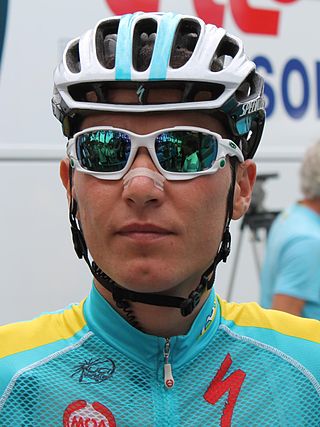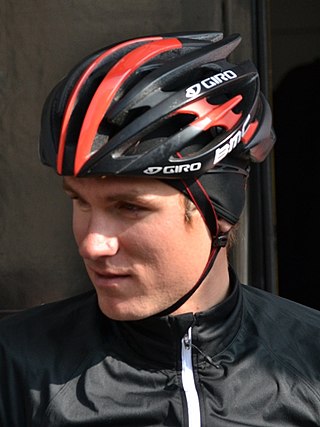
Christian Vande Velde is a retired American professional road racing cyclist of Belgian descent, who rode professionally between 1998 and 2013. Vande Velde competed for the U.S. Postal Service, Liberty Seguros, Team CSC and Garmin–Sharp squads. He has been a cycling analyst for NBC Sports since 2014. He is the son of cyclist John Vande Velde.

Janez "Jani" Brajkovič is a racing cyclist from Metlika, Slovenia, who most recently rode for UCI Continental team Adria Mobil. He was the world under-23 Time Trial champion in 2004.

The 2009 season for the Astana cycling team began in January with the Tour Down Under and ended in October with the Giro di Lombardia. As a UCI ProTour team, they were automatically invited to and obliged to attend every UCI ProTour event, and were invited to every event in the inaugural UCI World Calendar as well.

Team RadioShack was a professional road bicycle racing team, with RadioShack as the title sponsor, the creation of which was announced on July 23, 2009. Lance Armstrong co-owned and led the team, which raced in the Grand Tours and the UCI ProTour. The team was managed by Capital Sports and Entertainment, an Austin, Texas sports and event management group that also manages the Trek-Livestrong U23 development cycling team and that ran the former Discovery Channel Pro Cycling Team.

The 2010 Tour of California was the fifth running of the Tour of California cycling stage race. It was held from May 16–23, and was the first edition of the race held in the month of May, after the first four occurred in February. It was rated as a 2.HC event on the UCI America Tour. It began in Nevada City and concluded in the Agoura Hills.
The 2010 season for Team RadioShack, its first, began in January with the Tour Down Under and ended in October at the Giro di Lombardia. Team RadioShack rode in 2010 a UCI ProTour team, and was thus automatically invited to and obligated to send a squad to every ProTour event.
The 2010 Volta ao Algarve was the 36th edition of the Volta ao Algarve cycling stage race. It was held from 17 to 21 February 2010, and was rated as a 2.1 event on the UCI Europe Tour. It started at the Algarve Stadium in Faro and ended with an individual time trial in Portimão.

Tejay van Garderen is an American former professional road racing cyclist, who rode professionally between 2008 and 2021 for the Rabobank Continental Team, HTC–Highroad, BMC Racing Team and EF Education–Nippo. Following his retirement as a cyclist, van Garderen became a directeur sportif for UCI WorldTeam EF Education–EasyPost.

The 2012 Tour de France was the 99th edition of the Tour de France, one of cycling's Grand Tours. It started in the Belgian city of Liège on 30 June and finished on the Champs-Élysées in Paris on 22 July. The Tour consisted of 21 stages, including an opening prologue, and covered a total distance of 3,496.9 km (2,173 mi). As well as the prologue, the first two stages took place in Belgium, and one stage finished in Switzerland. Bradley Wiggins won the overall general classification, and became the first British rider to win the Tour. Wiggins's teammate Chris Froome placed second, and Vincenzo Nibali (Liquigas–Cannondale) was third.
The 2011 season for the Garmin–Cervélo cycling team began in January at the Tour Down Under and ended in October at the Noosa Grand Prix. As a UCI ProTeam, they were automatically invited and obligated to send a squad to every event in the UCI World Tour.
The 2011 season for HTC–Highroad began in January at the Tour Down Under and ended in October at the Chrono des Nations. As a UCI ProTeam, they were automatically invited and obligated to send a squad to every event in the UCI World Tour. This was the team's final season, as they failed to secure a new title sponsor.
The 2011 season for Team RadioShack began in January at the Tour Down Under and ended in October with Robbie McEwen's participation in the Noosa Grand Prix. As a UCI ProTeam, they were automatically invited and obligated to send a squad to every event in the UCI World Tour.
The 2011 Amgen Tour of California was the sixth running of the Tour of California cycling stage race. It was held from May 15–22, and was rated as a 2.HC event on the UCI America Tour. Originally scheduled for eight stages, the race was due to begin in South Lake Tahoe, but snow around the Lake Tahoe area led to stage 1 being delayed, shortened and ultimately cancelled. The race concluded in Thousand Oaks as planned.
The 2010 Tour of Utah was the seventh edition of the Tour of Utah. It was held August 17-22, 2010. The race was distinguished by the decision of the organizers prior to the race to submit the 2011 edition of the race for addition to the UCI America Tour, upgrading it from national status to international status. Although UCI Pro Tour team were not allowed to compete in the race, Levi Leipheimer of Team RadioShack, who had just won the Leadville Trail 100 MTB mountain-bike race in Colorado, raced as the sole member of a team sponsored by Lance Armstrong's Austin bicycle shop, Mellow Johnny's, and won the overall title. Consistent with its self-proclaimed title of "America's toughest stage race", only 71 of the original 140 starters finished the race.

The 2012 Volta a Catalunya was the 92nd running of the Volta a Catalunya cycling stage race. It started on 19 March in Calella and ended on 25 March in Barcelona, and consisted of seven stages. It was the fifth race of the 2012 UCI World Tour season.

The 2012 Tour de Romandie was the 66th running of the Tour de Romandie cycling stage race. It started on 24 April in Lausanne and ended on 29 April in Crans-Montana and consisted of six stages, including a race-commencing prologue stage and a race-concluding individual time trial. It was the 14th race of the 2012 UCI World Tour season.
The 2012 Amgen Tour of California was the seventh running of the Tour of California cycling stage race. It was held from May 13–20, and was rated as a 2.HC event on the UCI America Tour. It began in Santa Rosa and concluded in front of Los Angeles's Staples Center after eight stages. As per the Union Cycliste Internationale rules adopted in 2011, the use of race radios was prohibited, since only the events which are designated UCI World Tour events can use the devices.
The 2012 Tour of Utah was the ninth edition of the Tour of Utah. Once again, the race was included on the UCI America Tour, with a UCI classification of 2.1. As such, the race is only open to teams on the UCI Pro Tour, UCI Professional Continental and UCI Continental circuits. The race took place between August 7–12, 2012 as a six-day, six-stage race, with some major differences to the prior editions, such as the elimination of the prologue and the inclusion of a team time trial instead of an individual time trial. The 2012 Tour of Utah was one of five UCI-ranked stage races in the United States in 2012 and one of three that attracted multiple ProTeams to compete.
The 2012 USA Pro Cycling Challenge was the second edition of the USA Pro Cycling Challenge stage race. The race took place from August 20–26, and was rated as a 2.HC event on the UCI America Tour. The race began in Durango, wound its way through the Rocky Mountains at heights of up to 12,000 feet (3,700 m), and finished in the streets of downtown Denver.

The 2013 Amgen Tour of California was the eighth running of the Tour of California cycling stage race. It was held from May 12–19, and was rated as a 2.HC event on the UCI America Tour. It began in Escondido and finished in Santa Rosa.









